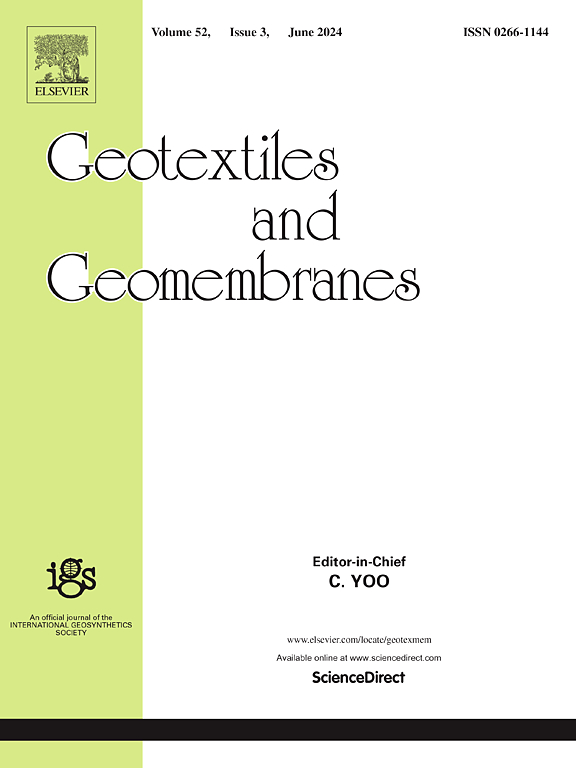Connection failure between reinforcement and facing in geosynthetic reinforced soil bridge abutments: A case study
IF 6.2
1区 工程技术
Q1 ENGINEERING, GEOLOGICAL
引用次数: 0
Abstract
Geosynthetic-reinforced soil (GRS) bridge abutments are increasingly used in transportation engineering. However, limited research has been conducted on the failure mechanisms of GRS bridge abutments, particularly the connection failures between reinforcement and facing. In this study, large-scale model tests were carried out to investigate the impact of connection failure between reinforcement and facing on the overall stability of GRS bridge abutments. The tests focused on a weaker connection configuration using low-strength cable ties subjected to high vertical loads. Photographic analysis was employed to document deformation and failure processes, while additional data were collected via sensors to monitor settlement, lateral displacement, and strain behavior during loading. The results indicated that inadequate connections between reinforcement and facing could result in progressive deformation, panel detachment, backfill leakage, and collapse under high loads. These findings underscore the importance of a strong connection between reinforcement and facing for maintaining structural stability. To address these issues, improved measures were proposed and validated, demonstrating significant enhancements in load-bearing performance and resilience.
土工合成加筋土桥台配筋与桥面连接失效案例研究
土工合成材料加固土(GRS)桥墩在交通工程中的应用越来越广泛。然而,有关土工合成材料加固桥台失效机理的研究,尤其是加固层与面层之间的连接失效的研究还很有限。在本研究中,我们进行了大规模的模型试验,以研究钢筋和面层之间的连接失效对 GRS 桥墩整体稳定性的影响。测试主要针对在高垂直荷载下使用低强度拉索的较弱连接结构。采用照片分析记录变形和失效过程,同时通过传感器收集其他数据,以监测加载期间的沉降、横向位移和应变行为。结果表明,在高荷载作用下,钢筋和面层之间的连接不足会导致渐进变形、面板脱落、回填渗漏和坍塌。这些发现强调了钢筋和面层之间牢固连接对于保持结构稳定性的重要性。为解决这些问题,我们提出了改进措施并进行了验证,结果表明这些措施显著提高了承重性能和回弹性。
本文章由计算机程序翻译,如有差异,请以英文原文为准。
求助全文
约1分钟内获得全文
求助全文
来源期刊

Geotextiles and Geomembranes
地学-地球科学综合
CiteScore
9.50
自引率
21.20%
发文量
111
审稿时长
59 days
期刊介绍:
The range of products and their applications has expanded rapidly over the last decade with geotextiles and geomembranes being specified world wide. This rapid growth is paralleled by a virtual explosion of technology. Current reference books and even manufacturers' sponsored publications tend to date very quickly and the need for a vehicle to bring together and discuss the growing body of technology now available has become evident.
Geotextiles and Geomembranes fills this need and provides a forum for the dissemination of information amongst research workers, designers, users and manufacturers. By providing a growing fund of information the journal increases general awareness, prompts further research and assists in the establishment of international codes and regulations.
 求助内容:
求助内容: 应助结果提醒方式:
应助结果提醒方式:


